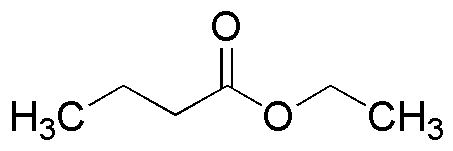Ethyl butyrate is widely utilized in research focused on:
- Flavoring and Fragrance Industry: Commonly used as a flavoring agent in food products and beverages, ethyl butyrate imparts a fruity aroma reminiscent of pineapple or apple, enhancing the sensory experience for consumers.
- Perfume Formulation: In the cosmetics industry, it serves as a key ingredient in perfumes and personal care products, contributing to the overall scent profile and providing a refreshing note.
- Solvent Applications: This compound acts as an effective solvent in various industrial processes, particularly in the formulation of paints, coatings, and adhesives, due to its ability to dissolve a wide range of substances.
- Biochemical Research: Ethyl butyrate is used in laboratories for studying metabolic pathways and enzyme activities, offering insights into biochemical processes and potential therapeutic applications.
- Agricultural Uses: It is also explored in agricultural settings as a potential attractant for certain pests, aiding in pest management strategies and reducing reliance on synthetic pesticides.
General Information
Properties
Safety and Regulations
Applications
Ethyl butyrate is widely utilized in research focused on:
- Flavoring and Fragrance Industry: Commonly used as a flavoring agent in food products and beverages, ethyl butyrate imparts a fruity aroma reminiscent of pineapple or apple, enhancing the sensory experience for consumers.
- Perfume Formulation: In the cosmetics industry, it serves as a key ingredient in perfumes and personal care products, contributing to the overall scent profile and providing a refreshing note.
- Solvent Applications: This compound acts as an effective solvent in various industrial processes, particularly in the formulation of paints, coatings, and adhesives, due to its ability to dissolve a wide range of substances.
- Biochemical Research: Ethyl butyrate is used in laboratories for studying metabolic pathways and enzyme activities, offering insights into biochemical processes and potential therapeutic applications.
- Agricultural Uses: It is also explored in agricultural settings as a potential attractant for certain pests, aiding in pest management strategies and reducing reliance on synthetic pesticides.
Documents
Safety Data Sheets (SDS)
The SDS provides comprehensive safety information on handling, storage, and disposal of the product.
Product Specification (PS)
The PS provides a comprehensive breakdown of the product’s properties, including chemical composition, physical state, purity, and storage requirements. It also details acceptable quality ranges and the product's intended applications.
Certificates of Analysis (COA)
Search for Certificates of Analysis (COA) by entering the products Lot Number. Lot and Batch Numbers can be found on a product’s label following the words ‘Lot’ or ‘Batch’.
*Catalog Number
*Lot Number
Certificates Of Origin (COO)
This COO confirms the country where the product was manufactured, and also details the materials and components used in it and whether it is derived from natural, synthetic, or other specific sources. This certificate may be required for customs, trade, and regulatory compliance.
*Catalog Number
*Lot Number
Safety Data Sheets (SDS)
The SDS provides comprehensive safety information on handling, storage, and disposal of the product.
DownloadProduct Specification (PS)
The PS provides a comprehensive breakdown of the product’s properties, including chemical composition, physical state, purity, and storage requirements. It also details acceptable quality ranges and the product's intended applications.
DownloadCertificates of Analysis (COA)
Search for Certificates of Analysis (COA) by entering the products Lot Number. Lot and Batch Numbers can be found on a product’s label following the words ‘Lot’ or ‘Batch’.
*Catalog Number
*Lot Number
Certificates Of Origin (COO)
This COO confirms the country where the product was manufactured, and also details the materials and components used in it and whether it is derived from natural, synthetic, or other specific sources. This certificate may be required for customs, trade, and regulatory compliance.

